On May 22-23, 2018, the Seventh International Conference on the Jasenovac Concentration Camp was held in Banja Luka. It was dedicated to the memory of the Serbs, Jews and Gypsies (Romanies) that became victims of the Ustase (Ustasha) genocide between 1941 and 1944. It was organized by the Jasenovac-Donja Gradina Association. Its chairman is Srboljub Zivanovic, a world-renowned expert on the Second World War and the Croatian genocide. For him the genocide of Serbs in Croatia is a personal tragedy: the Ustase murdered his parents before his own eyes. Under the Yugoslav dictator Josip Tito Professor Zivanovic was persecuted for revealing the awful truth of the massacre of 700,000 Serbs, 80,000 Gypsies, and 20,000 Jews in Croatian concentration camps during the Second World War. The conference gathered over sixty participants from Serbia, Russia, England, France, and the USA. The first speaker at the conference was President of Republika Srpska Milorad Dodik who called on everybody to study the Jasenovac tragedy more closely lest we repeat it. One of its attendees was a regular contributor to Pravoslavie.ru, Protodeacon Vladimir Vasilik, Doctor of History, Candidate of Theology, senior lecturer at St. Petersburg State University. Below we offer our readers his report.
At the present time the official Vatican and historians of the Roman Catholic Church tend to portray the genocide of Serbs in Croatia during the Second World War only as a result of a tribal strife and extreme nationalism in which the Catholic Church allegedly was not involved.
Catholic analysts particularly try to shield Monsignor Archbishop Aloysius (Alojzije) Stepinac of Zagreb, who was beatified by Pope John Paul II and canonized by Francis I, along with Pope Pius XII during whose pontificate these atrocities were committed.
Right after the axis invasion of Yugoslavia (involving German, Italian, Hungarian, and Bulgarian military units) the Ustase regime promulgated race laws for the so-called “Independent State of Croatia”, taking the Nuremberg Race Laws as their model. These laws were formally directed against Serbs, Jews, and Gypsies, yet their main targets were Serbs, Orthodoxy, and the Orthodox worldview. On April 17, 1941, the day of the capitulation of Yugoslavia, the Decree for the Protection of the People and the State was passed. It imposed the death penalty for threatening the interests of the Croatian people or the existence of the Independent State of Croatia. On April 25 the law prohibiting the Cyrillic alphabet was issued1 and on April 30 it was followed by the Law on the Protection of Aryan Blood and the Dignity of Croatian People. Serbian citizens were required to wear armbands bearing the letter “P”, for “Pravoslavac” (meaning “Orthodox”)2. On May 5, 1941, the Ustase Government passed a resolution declaring the Serbian Orthodox Church on the territory of the independent Croatia as “illegal”. On May 9 the Serbian Metropolitan Dositej (Vasic) of Zagreb was arrested. On June 2, by order of the Ustase, all the Serbian Orthodox primary schools and preschools were shut down3. Among those behind these directives were Catholic ideologues, including Archbishop Aloysius (Alojzije) Stepinac of Zagreb.
These decrees marked the beginning of the extermination of the Serbian Orthodox clergy. A host of Serbian New Martyrs who shone forth in that period were canonized by the Serbian Orthodox Church in the late twentieth century. Among them are Metropolitan Petar (Zimonjić) of Dabar-Bosna (commemorated on the third Sunday of September), Metropolitan Dositej (Vasic) of Zagreb (feast: January 13) and others.
Below we cite a few biographies of the New Martyrs of Serbia.
“Following the German occupation of the Kingdom of Yugoslavia brutal persecutions of Orthodox Serbs in Bosnia began. On the night of May 5, 1941, the Croatian Ustase seized the sick Bishop Platon of Banja Luka, killed him, and cast his corpse into the River Vrbanja4.”
Here is an account of the martyrdom of Fr. Branko Dobrosavljevic:
“On May 6, 1941, on his name day (or Slava; the feast of the Greatmartyr George), Archpriest Branko was captured by the Croatian Ustase headed by a teacher from Veljun named Ivan Sajfor. His son Nebojsa, a medical student, Priest Dimitrije Skorupan, rector of the parish at Cvijanovic Brdo, along with around 500 other Serbs were seized with him. They were locked up at the police station of Veljun and severely tortured, especially Fr. Branko’s son Nebojsa. The Ustase tried to force Fr. Dobrosavljevic to perform a funeral service over his own son, who was still alive at the time. In the morning of May 7, 1941, all of them were brought to the woods of Kestenovac, near Hrvatski Blagaj, where they were killed. In 1946, the remains of Archpriest Branko and his martyred companions were removed to Veljun and interred in a common grave5.”
And here is an account of the martyrdom of Metropolitan Petar (Zimonjić) of Dabar-Bosna:
“At the beginning of the German occupation of Yugoslavia in 1941 Metropolitan Petar was advised to leave Sarajevo for several days and wait until the end of the first wave of the Croatian terror, but he decided to remain with his people. After giving explanations to the German and Croatian authorities along with the Catholic Bishop Bozidar Brale (who forbad the Orthodox to use the Cyrillic alphabet) the metropolitan was caught and incarcerated in the Sarajevo prison on May 12, 1941. After severe trials in Zagreb and Gospic, Metropolitan Petar was put to death at the Jasenovac Concentration Camp and his body was cremated6.”
The martyrdom of Serbian Orthodox clergy was just the prologue to the terrible tragedy of Orthodox Serbs in the Independent State of Croatia. The number of Serbs murdered by the Ustase is still the subject of much debate. Thus, according to the Synodal Commission of the Serbian Orthodox Church, 800,000 Orthodox Serbs were killed, 300,000 were expelled, and 240,000 forcibly converted to Catholicism. In our view, the actual death toll is higher than the official count. The Croats put to death 700,000 people in Jasenovac alone. Most of them were Orthodox Serbs, and the rest Jews and Gypsies.
Jasenovac was not the only concentration camp. There was also the Jadovno camp where, according to various estimates, between 45,000 and 75,000 people were killed. About 70,000 people (mainly women) were exterminated at the Stara Gradiska Concentration Camp. It is noteworthy that the latter was run by… Catholic nuns. We cannot but mention the Slana Concentration Camp on the Croatian island of Pag, where the Ustase killed around 10,000 Serbs. These are just several of the twenty Croatian camps where the Ustase tried to deliberately annihilate Serbs. In fact many Serbs never reached the camps.
The way concentration camp prisoners died was horrific. Some died of famine, backbreaking labor, and epidemics. Some were executed by shooting, but the majority of them were killed with cold steel: The Ustase would cut their throats with special knives (“Serb-cutters”), fracture their skulls with hammers, cut off their hands, legs, fingers, ears, lips, put out their eyes, hack off women’s breasts. It was said that one Ustase soldier used to wear beads made of Serbs’ eyes, and another one a belt with Serbs’ tongues hanging from it7. Some Serbs were forced to drink the warm blood of their relatives who had just been butchered, after which they were stabbed to death as well.
The atrocities of the Thirty Years’ War (1618-1648), when Wallenstein’s Croatian soldiers chopped off Czech children’s arms and pinned them on their caps, were repeated in the twentieth century. Can we explain these inhuman, brutal actions by the “ethnic savageness” and “archaic fanaticism” of the Croats? And the answer is, “no”.
As is generally known, an ideology gives resolution to a murderer. The ideology of the Ustase (meaning “rebels”, “insurgents”) and their head (later, the “President” of the puppet “Independent State of Croatia”) can be characterized as clerical fascism. The Ustase strove for full Croatian independence, and once they gained independence through radical measures, they recognized only Croats and Germans as Croatian citizens and gave them honorary Aryan citizenship, while Serbs, Jews, and Gypsies became “state property”, like cattle. Ante Pavelic was uncompromising: For “the final solution to the Croatian question” one third of the Serbs were to be killed, one third were to be forcibly converted to Catholicism, and one third were to be expelled. His slogan was: “Either across the Drina or beyond the Drina”. And this is how this slogan was implemented: Corpses with plates bearing the words “to Belgrade for King Peter”, along with severed children’s heads with the plates, “to the Belgrade market” were drifted down the River Drina8. It should be noted that Pavelic was a devout Catholic. Even in exile in Argentina he would listen to the mass every day. He imagined the state of Croatia as a bastion of Catholicism in opposition to Orthodoxy, Islam, and Communism. He was a “staunch fighter” for traditional Catholic values and called upon his comrades-in-arms to be ruthless: “We have no right to be humane.”
And the Roman Catholic Church together with its representatives was involved in all of this. On May 5, 1941, Pavelic jointly with the Minister of Education and Cults Mile Budak adopted the Religious Conversion Law that obliged the Orthodox to convert to Catholicism. It was Mile Budak who announced during his speech in Gospic on June 22, 1941: “We shall slaughter one third of the Serbs, deport another third, and force the last third into Roman Catholicism and thus make them Croats. We shall destroy every trace of theirs, and all that will be left will be a bad memory of them. For Serbs, Jews, and Gypsies we have three million bullets!9”
It should be stressed that this awful speech was reprinted in the Kuria of Zagreb’s official journal, Katolicki List.
Immediately after that the same journal published the message of Monsignor Archbishop Aloysius (Stepinac) of Zagreb who defined Serbs as “renegades from the Catholic Church” and welcomed the new law. On July 31 of that year the same periodical called for an acceleration of the process of the conversion of Serbs to Catholicism. In 1943, Stepinac wrote to the Vatican that 240,000 Serbs had been converted to Catholicism in the Independent State of Croatia10.
This is the atmosphere in which the “conversion”, or, to be more exact, the forced conversion of Serbs to Catholicism was being carried out. The call of Priest Dionizije Juricević, addressed to the residents of the village of Staza, where he came to forcibly baptize the Orthodox into Catholicism, was as follows:
“We are well aware where those who reject the Baptism will be sent. I have already ‘cleansed’ all these southern lands, from infants to elders. And I am ready to do the same here, if necessary, because today there would be no sin in killing a seven-year-old child if he is impeding the progress of our Ustase regime… Disregard my priestly vestments. Know that, if need be, I can take a submachine gun and annihilate all who will resist the state and the Ustase authorities11.”
But rebaptism didn’t guarantee life. The Ustase would often lock the newly-baptized Serbs in Orthodox churches and burn them alive or use some other methods of execution, explaining to the converts: “We need your souls and not your bodies.12” Notably, only peasants were rebaptized, while Serbs living in towns were doomed to annihilation as they were regarded as bearers of the Serbian national consciousness and unfit for re-education.
Monsignor Archbishop Aloysius (Stepinac) approved all of this. More than that, Pope Pius XII thanked Stepinac and Catholic priests for their efforts to convert the “schismatics”13. Stepinac informed the pope that 240,000 Orthodox Serbs had been converted to Catholicism.
Catholic priests, monks and nuns took the most active part in the genocide of Orthodox Serbs. The second Commandant of the notorious Jasenovac camp was a Franciscan priest named Miroslav Filipovic. “Every night he left his house to slaughter and returned at dawn with his vestments stained with blood… Once a prisoner was led up to him when Filipovic was dining. The priest stood up and coolly murdered him. After that he sat down and finished his dinner, saying: ‘Call a grave digger.’” It was said that he would enjoy drinking his victims’ blood and repeat: “This is the Communist and Jewish blood! Let me drink my fill!” And he was not the only clergyman-butcher of Jasenovac. There were also the infamous Jasenovac guards, Monks Majstorovic, Brkljanic, and Bulanovic, who would kill the camp’s prisoners.
Franciscan monks carried out mass executions in the villages of Drakulic and Sargovac near Banja Luka where about 2,000 Serbs were slaughtered. An Ustase detachment that carried out “ethnic cleansing” of Serbs was commanded by Monk Avgustin (Cevola) who would always carry arms in his hands. Monk Sidonije (Scholz) forcibly converted Serbs to Catholicism and was not afraid to massacre Serbian priests and laity who refused to become Catholics. A Catholic priest from Udbina, Mate Mogus, in his sermon called on the faithful to expel Serbs from Croatia or exterminate them.
And there were thousands of such examples. According to the International Commission for the Truth on Jasenovac, 1,400 Catholic priests (two thirds of the total number) were involved in the genocide. The barbarous cruelty of Catholic priests went beyond all bounds, so that even Germans (who would not scruple to shoot 100 Serbian captives for one German soldier) had to intervene. Thus, Priest Mata Gravanovic was executed together with several Ustase by the Nazis for… mass atrocities against Serbs. Catholic clerics were involved in the genocide right until the end of the war.
Realizing that it is impossible to save the reputation of the Croatian clergy, apologists of the Catholic Church are trying to whitewash Archbishop Aloysius (Stepinac) of Zagreb, claiming that he either didn’t know about the horrific crimes of his clergy and flock or actively struggled against them. Neither version holds water. Stepinac was a well-informed man and too power-hungry not to have control of his own diocese. As to the allegation that Stepinac “struggled against the clergy who were subordinate to him”, we don’t find any signs of this struggle. As the leader of the military clergy in Croatia Stepinac did nothing to prevent those under his authority from committing these heinous crimes. More than that, he awarded murderers with icons and crosses instead of excommunicating them. He supported the “Poglavnik” [the Ustaše leader Ante Pavelić] and his program, accepted his awards, backed up the new authorities in every way and publicly encouraged all that was going on in Croatia14. Therefore, at least as a propagandist and administrator who covered up the crimes, he was involved in the genocide.
Stepinac played a major role in the neutralization of any possible opposition to the genocide in the Vatican. In 1941, he actively advocated for diplomatic recognition of the Independent State of Croatia by the Vatican, which the latter finally did de facto. What’s more, Pope Pius XII would meet delegations of the Croatian Ustase in Rome, although Rome did receive reports of their atrocities. Due to the diplomatic efforts of Archbishop Stepinac, coupled with the pope’s total disinclination to believe these reports, they remained “a voice crying in the wilderness”15, as it were. As a result, Ante Pavelic didn’t worry about the position of the Vatican. A representative of the “Independent State of Croatia”, Nikola Rusinovic, wrote that during a conversation with Undersecretary of the State of Vatican Giovanni Battista Montini about the crimes of the Ustase regime the latter noted that, “the Vatican regards any negative information about Croatia with suspicion.16” The only person in the Vatican to protest against the genocide of Serbs was the learned theologian Eugene Disserant, but he was treated as an idiot who was not to be trusted. Pius XII turned a deaf ear to this evidence not only because of his servile attitude to Hitler and Mussolini, but also because he admired the zeal of Ante Pavelic and his subjects in spreading “the true faith” among “schismatics”, and was impressed by his brutal determination to implement a full-scale Catholic project, which would become a stronghold against “the socialist menace” as contrasted to the liberalism of Western democracies. Moreover, he was attracted by a chance to do away with the main rival of Roman Catholicism in the Western Balkans, namely the Serbian Orthodox Church. As for the hundreds of thousands of murdered Orthodox Christians, he thought that “the war will write off all sins”, and, “Victors are not judged”. In case of failure they could dissociate themselves from the “savage Croatian nationalists”17.
After the end of the war, the Vatican took active part in the “ratlines” operation to help the Ustase, including Catholic clerics, escape justice. Among those who helped the Ustase in Rome were the Austrian (a Croat by descent) Aloyse Gudal and the Pontifical Croatian College of St. Jerome headed by Krunoslav Draganovic. Through his support a large number of Ustase leaders and clerics who had collaborated with them (headed by Bishop Ivan (Saric)) fled from Croatia with the stolen gold and hid in Rome18. It cannot be ruled out that Pavelic escaped punishment due to Pius XII’s intercession: When an American intelligence officer tried to hunt for the “bloody Poglavnik”, the pontiff insisted on his deportation19.
Nevertheless, a number of butchers, including those in cassocks, received their just punishment. After the war the Yugoslav authorities arrested some priests who had been involved in the crimes. Several hundred Catholic priests were prosecuted and after a proper legal trial, many of them were sentenced to capital punishment. Of course, Archbishop Aloysius (Stepinac) was brought to justice too; he was sentenced to sixteen years of imprisonment and hard labor for his collaboration and involvement in the genocide. However, he served his term for only five years, was exempted from penal servitude, and was later confined to house arrest at his native village of Krasic. By the standards of those stern days he “got off with nothing more than a good fright”. In time he was declared a “martyr” and a “victim of Communism”. In 1998, Stepinac was beatified by John Paul II, and in 2015 he was canonized by Pope Francis. The canonization of Stepinac is tantamount to spitting on the hundreds of thousands of victims of the genocide (unleashed by the Ustase), and admitting to the involvement of the Vatican in these crimes. Pope Pius XII didn’t react to the terror in Croatia, albeit he was well-informed about it20. The pope didn’t excommunicate any of the executioners, while he excommunicated all Communists in 1949. On top of that, this pontiff was a long-standing supporter of the inhuman Ustase regime in the world arena and preferred to help hundreds if not thousands of war criminals escape through the Vatican “ratlines”.
But how can we explain this inhumanity and utter contempt for the Christian values?
There is a concept of spiritual delusion, or “prelest” (in Russian), in the Orthodox ascetical tradition, which has to do with demonic influence and deception. It was not without reason that Christ warned us: Yea, the time cometh, that whosoever killeth you will think that he doeth God service (Jn. 16:2). Unfortunately, this spiritual blindness is a natural phenomenon in Roman Catholic asceticism and theology, specifically in its teaching of salvation through good works. For “good works” are tested by their aim; and, as we know, “the end justifies the means”. These butchers most probably believed that they were “martyrs of conscience” by taking upon themselves all these sins “for the sake of a greater and brighter future of the Croatian nation”, and for the triumph of the “holy Catholic faith”. Justifying themselves, they well may have recalled some verses from the Old Testament, like this one: The righteous shall rejoice when he seeth the vengeance: he shall wash his feet in the blood of the wicked (Ps. 58:10 KJV). And it is quite possible that while committing mass rape and murder, they would enter into a state of religious ecstasy.
And we should be aware of this and bear it in mind.

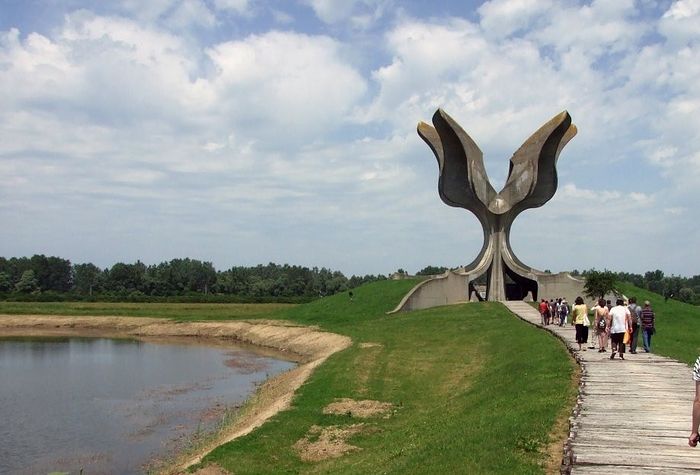
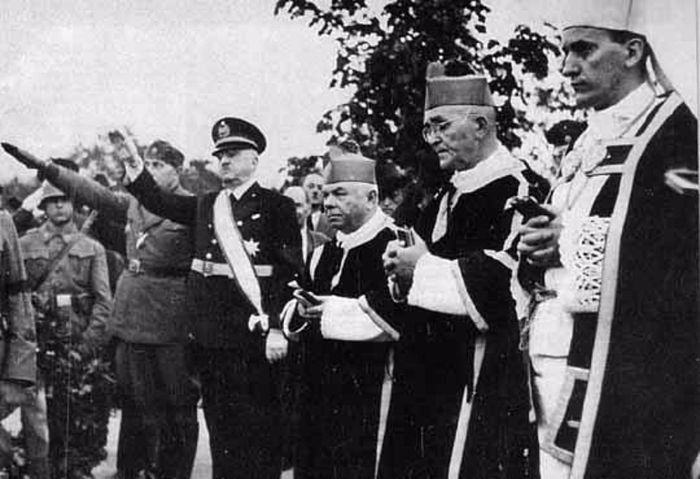
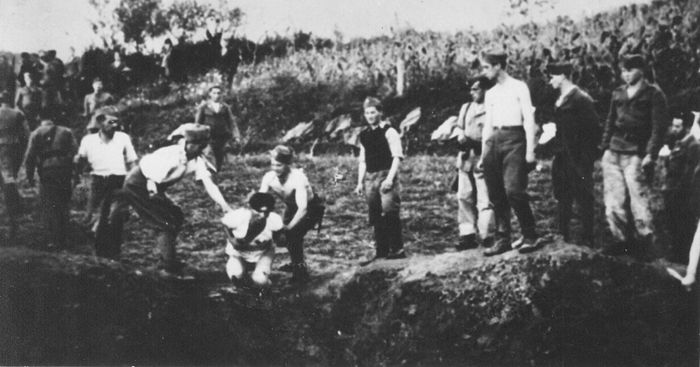
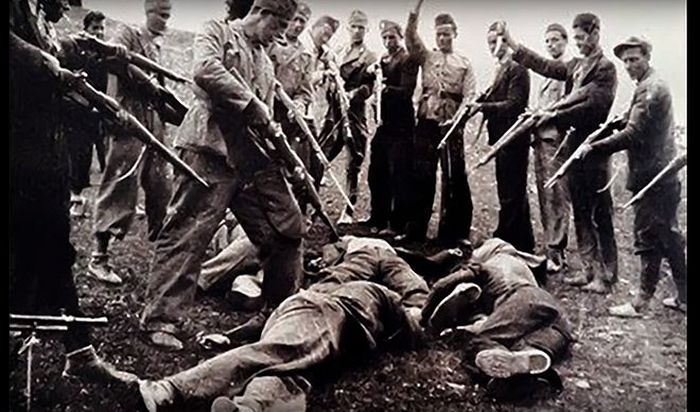
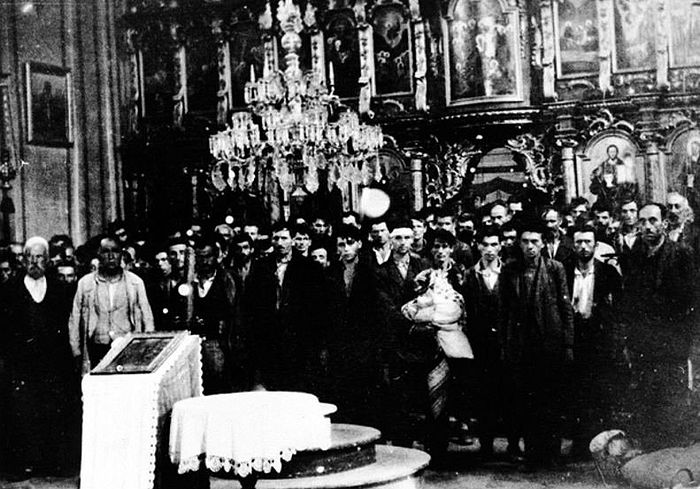
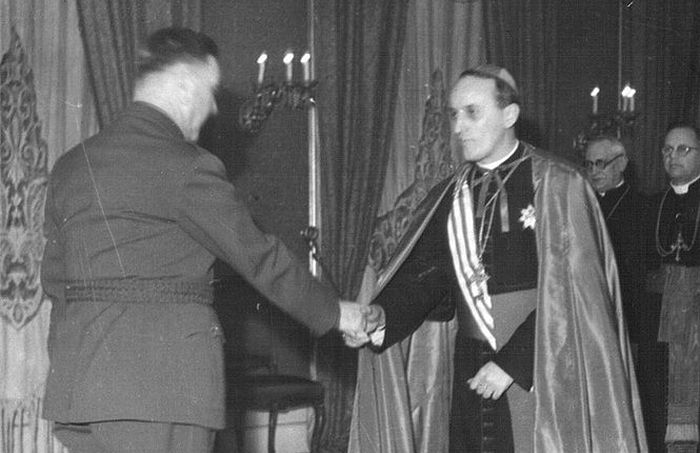
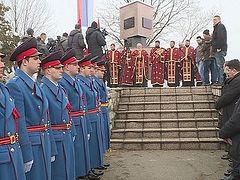

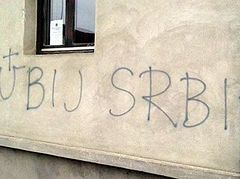
And pay more attention when writing my name too; not for me, but for the great saint whose name I unworthily bear.
============================================
Indeed. At the very least, he did nothing remarkable to stop the tortures and the assassinations, to stop the abomination.
Mutatis mutandis, his behaviour is very similar to the behaviour of a Metropolitan we know very well in the Russian Church. I heard very recently some Orthodox calling that Metropolitan a saint. He also have statues erected to him in very prominent places.
I won't name names, but I hope you share my alarm here as Orthodox for that.
The Lord spoke about the matter in Matthew 7, 1-5.
You don't go after silliness, just because the hierarchies (NOT the Church) have lost the required prudence. Just as they did again at the recent meeting in Crete. Should I remember you who and what?
Just as they have done everywhere many times since St. Constantine the Great. Three Patriarchs killed St. John Chrysostom.
The blasphemy is on those who put to shame Orthodoxy with such untenable number (a physical impossibility!!!). The martyrs of Jasenovac would lose no glory, even if they were just a dozen!
As the 6.000.000 Jews gassed in the German internment camps?
Give me a break!
Prelest is a two-edged sword, as our beloved brother Anthony should learn.